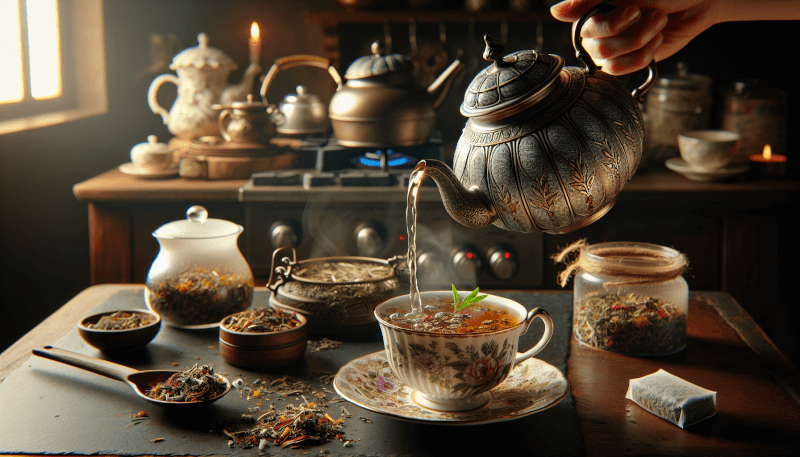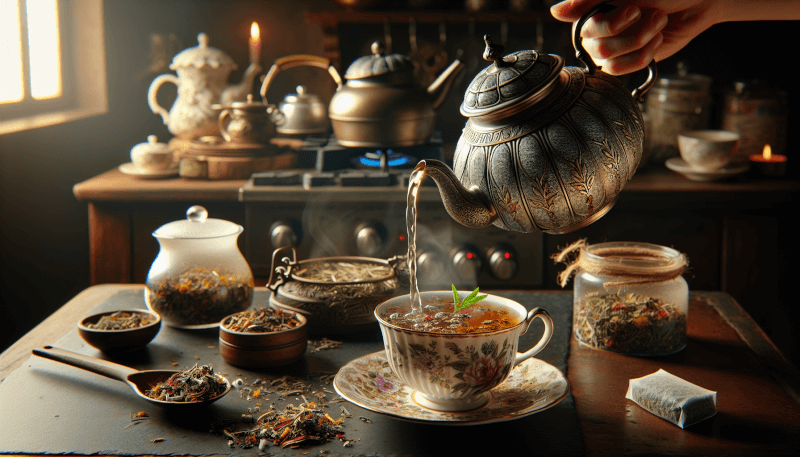Are you a tea enthusiast looking to expand your knowledge of herbal tea brewing methods? Look no further than the comprehensive “Ultimate Guide to Herbal Tea Brewing Methods.” This insightful article explores various techniques to help you brew the perfect cup of herbal tea at home. From steeping times and water temperatures to infusion methods and flavor profiles, this guide is your go-to resource for creating a delightful herbal tea experience. So grab your favorite teapot and get ready to embark on a journey of exploration and taste.
Choosing the Right Herbal Tea
When it comes to choosing the right herbal tea, there are a multitude of options to consider. Understanding the different types of herbal tea is the first step in finding the perfect blend for your taste buds and health needs.
Understanding the Different Types of Herbal Tea
Herbal teas, also known as tisanes, are derived from various plants, flowers, and herbs. Unlike traditional teas, such as black or green tea, herbal teas are not made from tea leaves. Instead, they are often made from a single ingredient or a combination of ingredients known for their unique flavors and health benefits.
Some common types of herbal tea include peppermint tea, chamomile tea, lemongrass tea, hibiscus tea, lemon verbena tea, ginger tea, rooibos tea, and echinacea tea. Each type offers its own distinct flavor profile and potential health benefits, making it important to explore and experiment with different options to find the ones that suit you best.
Considering Flavor Profiles and Health Benefits
When choosing herbal tea, it’s important to consider both the flavor profile and the potential health benefits of the ingredients. Peppermint tea, for example, is known for its refreshing and minty taste, while also offering digestive benefits. Chamomile tea, on the other hand, has a gentle and soothing flavor, often used to promote relaxation and sleep.
Taking the time to research the flavor profiles and benefits of different herbal teas can help you make an informed decision and discover the varieties that align with your preferences and wellness goals.
Selecting High-Quality Herbal Tea Leaves
To fully enjoy the flavors and benefits of herbal tea, it’s crucial to choose high-quality leaves. Look for reputable tea brands that prioritize sourcing the finest ingredients and use sustainable farming practices. Organic certifications are also a good indicator of quality.
When selecting herbal tea leaves, consider factors such as freshness, aroma, and appearance. Fresh leaves should have a vibrant color and a pleasant scent. Avoid leaves that appear stale or have a musty smell. Additionally, opt for leaves that are whole or in larger pieces, as they tend to be of higher quality.
Preparing Your Brewing Equipment
Now that you’ve chosen the perfect herbal tea, it’s time to prepare your brewing equipment. A well-equipped brew station will ensure that you can brew your tea to perfection every time.
Choosing the Right Teapot or Infuser
The type of teapot or infuser you choose can greatly influence the brewing process and the flavors of your herbal tea. Teapots made of ceramic or glass are often preferred, as they do not impart any unwanted flavors to the brew. Stainless steel infusers are also popular options, especially for loose-leaf herbal teas.
Consider the size of your teapot or infuser, as it should comfortably accommodate the amount of tea you wish to brew. Opt for a design that allows for easy cleaning and maintenance.
Gathering Essential Tools and Ingredients
In addition to a teapot or infuser, there are a few other tools and ingredients that can enhance your herbal tea brewing experience. Some essential items to gather include a tea kettle, a thermometer for measuring water temperature, a tea timer or smartphone app, and a tea strainer for removing leaves from the brewed tea.
You may also want to have some additional ingredients on hand to customize your herbal tea, such as sweeteners like honey or sugar, citrus or fruit zests, and milk or non-dairy alternatives.
Organizing Your Brewing Station
To create a calm and efficient brewing experience, it’s helpful to organize your brewing station. Find a dedicated space in your kitchen or home where you can set up your teapot, infuser, and other brewing tools. Keep your ingredients neatly organized and easily accessible.
A clean and organized brewing station not only makes it easier to brew your herbal tea, but it also adds to the enjoyment of the process. Take the time to create a pleasing environment that allows you to fully immerse yourself in the art of tea preparation.
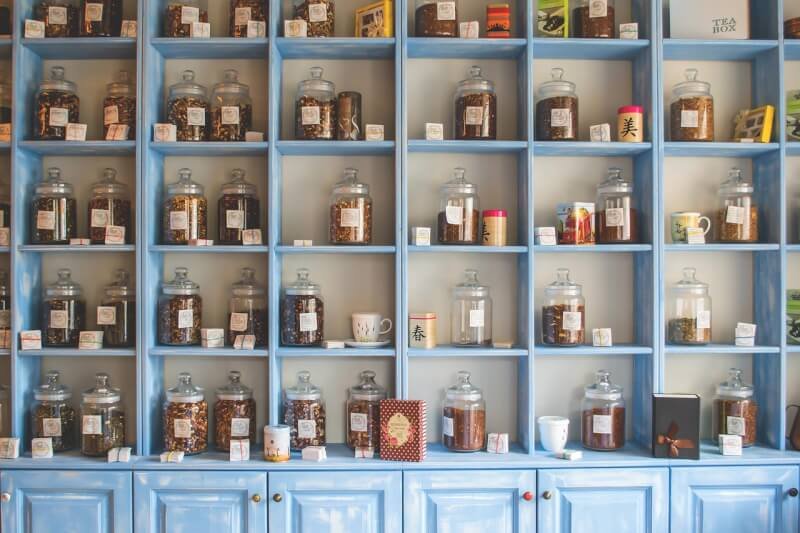
Water Temperature and Quality
Water is a crucial element in brewing herbal tea, and understanding its temperature and quality is key to achieving the optimal flavor and health benefits.
Understanding Optimal Brewing Temperatures
Different types of herbal tea require specific water temperatures for the best infusion. As a general rule, delicate herbal teas, such as chamomile or lemongrass, are best brewed with water that is around 185°F (85°C), while more robust herbal teas, such as ginger or hibiscus, can withstand higher temperatures, around 200°F (95°C).
Using water that is too hot can result in a bitter or astringent taste, while water that is too cool may not fully extract the flavors and beneficial compounds from the tea leaves.
Importance of Using Filtered Water
The quality of the water used to brew herbal tea can also impact the overall taste and quality of the infusion. Opting for filtered water is recommended, as it removes impurities and chemicals that can affect the flavor and clarity of the brewed tea.
Filtered water enhances the natural flavors of the herbal tea and allows for a cleaner and more enjoyable drinking experience. If filtered water is not readily available, allowing tap water to sit for a few minutes to let chlorine and other chemicals dissipate can also be a viable option.
Avoiding Overheating or Boiling Water
When heating water for herbal tea, it’s important to avoid overheating or boiling the water. Overheating the water can scorch the delicate leaves and result in a bitter brew. Boiling water, on the other hand, can reduce the oxygen content and result in a flat-tasting tea.
To ensure the water is at the ideal temperature, use a thermometer to measure the temperature or simply remove the water from heat just before it reaches a rolling boil. This will help preserve the delicate flavors and aromas of the herbal tea.
Proper Herbal Tea Leaf Measurement
To achieve the perfect infusion, it’s essential to measure the right quantity of herbal tea leaves. Proper measurement ensures optimal flavor extraction and avoids the risk of either oversteeping or underwhelming the brew.
Determining the Ideal Amount of Tea Leaves
The ideal amount of tea leaves can vary depending on personal preference and the type of herbal tea being brewed. As a general guide, a teaspoon of loose-leaf herbal tea per cup of water is a good starting point. Adjust the quantity according to your preferences for a stronger or milder brew.
For larger teapots or multiple servings, you may want to consider increasing the amount of tea leaves accordingly. It’s always better to start with a slightly smaller amount and gradually adjust to find the perfect balance of flavor.
Understanding the Tea-to-Water Ratio
The tea-to-water ratio is another important factor to consider when measuring herbal tea leaves. It determines the intensity and strength of the brewed tea. Generally, a ratio of 1 teaspoon of tea leaves to 8 ounces of water is a good baseline.
However, this ratio can be adjusted based on personal taste preferences. If you prefer a stronger brew, you can increase the amount of tea leaves, while a milder flavor can be achieved by reducing the quantity.
Measuring Tea Leaves with a Scale or Spoon
Measuring herbal tea leaves can be done using a scale or a simple teaspoon. If you have a kitchen scale, you can weigh the desired amount of tea leaves for a precise measurement. This method is especially helpful when following specific recipes or experimenting with new flavors.
If you don’t have a scale, a teaspoon can serve as a convenient measurement tool. Ensure that the leaves are level, neither packed too tightly nor too loosely. This will help maintain consistency in your brewing process.
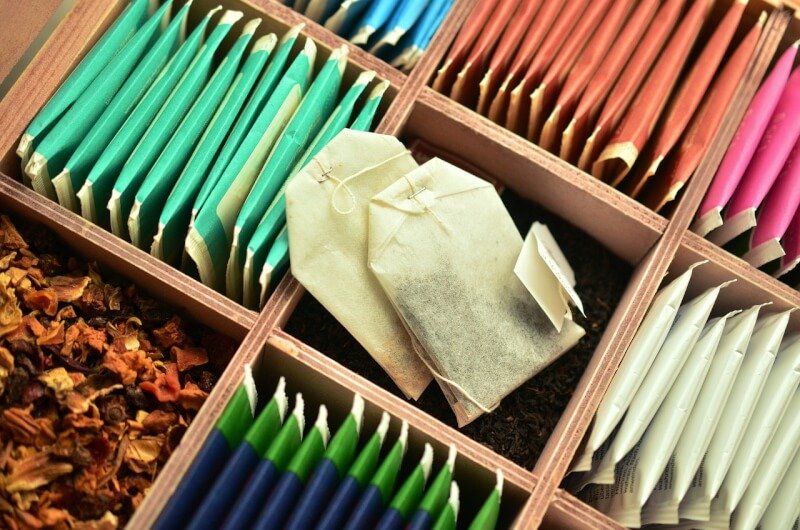
Infusing Time and Techniques
The duration of the infusion process greatly influences the flavor and strength of the herbal tea. Each type of herbal tea requires a specific steeping time to fully extract its flavors and therapeutic compounds.
Steeping Recommendations for Different Herbal Teas
Different herbal teas have varying steeping recommendations, and it’s important to follow these guidelines for the best results. For example, chamomile tea typically requires steeping for 5-7 minutes, while ginger tea benefits from a longer infusion of 10-15 minutes.
If you’re unsure about the recommended steeping time for a particular herbal tea, consult the packaging or do some research to find the optimal duration. Alternatively, you can start with a shorter steeping time and gradually increase it to suit your personal taste.
Understanding Steeping Time and Herbal Tea Types
In addition to individual steeping recommendations, it’s useful to have a general understanding of the various herbal tea types and their brewing characteristics. Delicate herbal teas, such as chamomile or lemongrass, generally require shorter steeping times, as they can become bitter if oversteeped. On the other hand, robust herbal teas, like ginger or hibiscus, can withstand longer steeping periods.
Over time, as you become more familiar with different herbal teas, you’ll develop a sense of the ideal steeping times for each type. Pay attention to the color and aroma of the brew as indicators of readiness.
Exploring Infusing Methods (hot brew, cold brew, etc.)
In addition to the traditional hot brew method, there are various other infusing techniques to explore and experiment with. Cold brewing, for example, involves steeping herbal tea in cold or room temperature water for an extended period, typically 6-12 hours. This method often results in a smoother and less bitter brew, perfect for enjoying herbal tea on hot summer days.
Another method to consider is sun brewing, where herbal tea is infused by placing it in a jar with water and allowing it to steep in direct sunlight for several hours. This method can produce unique flavors and is particularly enjoyable during warmer months.
Feel free to get creative and try different infusing methods to discover new dimensions of flavor in your herbal teas.
Tea Brewing Methods
Now that you’re familiar with the basics of herbal tea brewing, let’s explore the various methods you can use to create the perfect cup of tea.
Hot Brew Method
The traditional hot brew method is perhaps the most common way to prepare herbal tea. To start, bring filtered water to the appropriate temperature for your chosen herbal tea. Place the desired amount of tea leaves into a teapot or infuser, and pour the hot water over the leaves. Allow it to steep for the recommended duration, and then strain the tea leaves before serving.
Hot brewing is versatile and can be easily adapted to suit personal preferences and experimentation with flavors and steeping times.
Cold Brew Method
Cold brewing herbal tea is a refreshing alternative to hot brewing, especially during the summer months. To cold brew, add the desired amount of tea leaves to a container and pour cold or room temperature filtered water over them. Seal the container and refrigerate for several hours or overnight. Once the desired strength is achieved, strain the tea leaves and serve over ice.
Cold brewing results in a smoother and less bitter brew, allowing the delicate flavors of the herbal tea to shine through. It’s a great method for those who prefer a milder flavor profile.
Sun Brew Method
If you’re looking for a unique and natural brewing method, sun brewing is worth exploring. Start by placing the desired amount of tea leaves in a clean glass jar. Fill the jar with cold, filtered water and cover it with a lid. Place the jar in a sunny location, such as a windowsill, and allow it to steep for several hours, up to a full day.
Sun brewing imparts a light and subtle flavor to the herbal tea, with the sun’s warmth gently extracting the flavors from the leaves. It’s a delightful and relaxing method, perfect for taking advantage of sunny days.
Infusing Tea Bags
For those who prefer convenience and simplicity, pre-packaged tea bags are a popular option. Simply heat the water to the appropriate temperature, steep the tea bag for the recommended time, and remove the bag before enjoying the soothing flavors of herbal tea.
While tea bags offer convenience, they may not provide the same level of customization and freshness as loose-leaf herbal tea. However, they are a great option for those who are just starting to explore the world of herbal teas and want a convenient introduction.
Using Herbal Tea Tisanes
Herbal tea tisanes, also known as blends or mixtures of different herbs and plants, offer a world of flavors and health benefits. These pre-blended teas often combine various ingredients to create unique and harmonious flavor profiles.
When brewing herbal tea tisanes, it’s essential to follow the recommended brewing instructions provided by the manufacturer. Each blend may have specific steeping times and water temperatures to ensure the best balance of flavors.
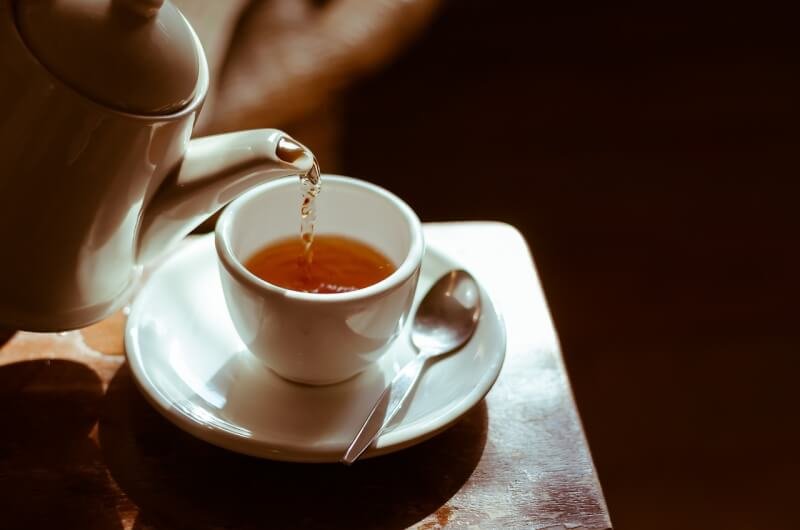
Enhancing Flavor with Additives
While herbal tea is delicious on its own, there are several additives that can enhance its flavor and bring a unique twist to your cup.
Experimenting with Sweeteners (honey, sugar, etc.)
Adding a touch of sweetness to herbal tea can elevate the flavors and make it a more enjoyable experience for those with a sweet tooth. Consider trying different sweeteners, such as honey, sugar, or even maple syrup, to find the perfect balance.
When adding sweeteners, start with a small amount and gradually increase to taste. Test different options with different herbal teas to discover your preferred pairings.
Adding Citrus or Fruit Zests
Citrus or fruit zests can lend a refreshing and bright note to herbal teas. Consider adding a small amount of lemon, lime, orange, or grapefruit zest to your brew. This can be done by gently grating the peel or using a zester to extract the flavorful oils.
Before adding the zest, ensure that the peel is thoroughly washed and free from any residue. Experiment with different types of citrus and fruits to discover your favorite flavor combinations.
Using Milk or Non-Dairy Alternatives
While herbal tea is typically enjoyed without milk, some people prefer a creamier and richer beverage. If you enjoy the comforting qualities of a milky infusion, consider adding a splash of milk or non-dairy alternatives, such as almond milk or coconut milk, to your herbal tea.
Milk can mellow the flavors and provide a smooth texture. Experiment with different types and quantities of milk to find the perfect balance that complements your chosen herbal tea.
Applying Steeping Techniques
Brewing herbal tea is not only a science but also an art. Various steeping techniques can enhance the overall experience and create a deeper connection to your tea.
Meditative Steeping Method
The meditative steeping method involves immersing yourself fully in the brewing process, focusing on each step with mindfulness and intention. Take a moment to admire the appearance of the tea leaves, inhaling their aroma deeply. As you pour the water over the leaves, visualize the infusion process and the transformation of the flavors. Engage all your senses as you observe the color and aroma of the brewed tea.
Embracing the meditative steeping method can create a sense of calm and relaxation, allowing you to fully appreciate the therapeutic benefits of herbal tea.
Traditional Gongfu Cha Technique
The traditional Gongfu Cha technique, originating from China, involves using a small teapot or gaiwan and multiple short steepings. This method allows for a greater exploration of the flavors and complexities of the herbal tea.
To practice Gongfu Cha, use a higher tea-to-water ratio and short steeping times, typically around 15-30 seconds. Pour off the tea into small cups, appreciating the evolving flavors with each infusion. Repeat the process multiple times, gradually increasing the steeping time to fully extract the essence of the tea leaves.
While the Gongfu Cha technique requires more time and attention, it offers a rewarding experience for true tea enthusiasts.
Multiple Steepings with the Same Leaves
Many high-quality herbal teas can be steeped multiple times, providing unique flavors and aromas with each infusion. Instead of discarding the leaves after the initial steeping, give them a second or even third infusion.
To achieve the best results, increase the steeping time slightly with each subsequent infusion, as the leaves have already started to expand and release their flavors. Explore the subtle variations in taste and aroma between each steeping, appreciating the complexities that unfold.
Multiple steepings allow you to maximize the value and enjoyment of your herbal tea leaves while creating a sensory journey with each infusion.
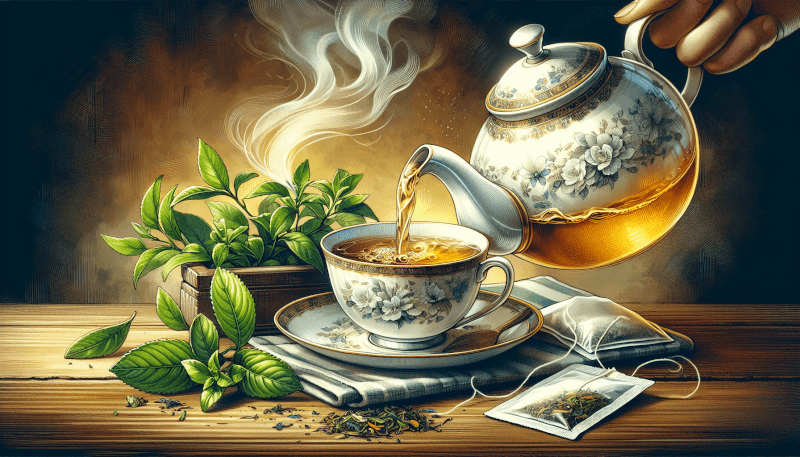
Decanting and Serving Herbal Tea
Once your herbal tea is perfectly infused, it’s time to decant and serve it in the most pleasing and enjoyable way possible.
Straining Tea Leaves from the Brew
To ensure a smooth and leaf-free cup of herbal tea, it’s essential to strain the tea leaves properly. Whether using a teapot with an internal strainer or a separate tea strainer, carefully pour the brewed tea through the strainer into your serving cup or teacup.
If you’re using a teapot without an integrated strainer, consider investing in a fine-mesh tea strainer. This will prevent any small particles from passing through and ensure a clean and clear brew.
Choosing the Right Teaware for Serving
The choice of teaware plays a significant role in enhancing the overall tea-drinking experience. Opt for teacups or mugs that are made of materials that retain heat well, such as ceramic or glass. These materials will keep your herbal tea hot for longer, allowing you to savor the flavors and aromas.
Consider the aesthetic appeal of your teaware as well. Choose designs and shapes that resonate with you and enhance the beauty of the herbal tea. Teaware can be an expression of your personality and a reflection of the ritualistic nature of tea brewing.
Serving Tea with Accompaniments (biscuits, scones)
To make your herbal tea experience even more enjoyable, consider serving it with a variety of accompaniments. Biscuits, scones, or pastries can provide a delightful and satisfying pairing. The subtle sweetness and textures of these treats can complement the flavors of the herbal tea and create a well-rounded experience.
Experiment with different types of accompaniments to find the perfect combination that enhances the flavors and elevates your enjoyment of herbal tea.
Exploring Different Herbal Tea Varieties
With knowledge of brewing techniques and a variety of additives, it’s time to delve into the world of herbal tea varieties. There are countless options to explore, each offering unique tastes and potential health benefits.
Peppermint Tea
Peppermint tea is known for its invigorating and refreshing flavor. It’s a popular herbal tea variety due to its digestive benefits and ability to soothe upset stomachs. Peppermint tea can be enjoyed on its own or combined with other herbal teas to create delightful blends.
Consider experimenting with different steeping times and infusing methods to find the perfect balance of flavor in your peppermint tea.
Chamomile Tea
Chamomile tea is renowned for its calming properties and gentle flavor. It’s often consumed before bedtime to promote relaxation and aid in sleep. Chamomile tea can be enjoyed on its own or blended with other herbs, such as lavender or lemon balm, for added complexity.
Experiment with different steeping times and consider infusing chamomile tea with a dash of honey to enhance its soothing qualities.
Lemongrass Tea
Lemongrass tea offers a bright and citrusy flavor, reminiscent of lemon and herbs. It is known for its cleansing and detoxifying properties. Lemongrass tea can be enjoyed hot or cold and can be combined with other flavors, such as ginger or mint, for a more complex taste.
Try infusing lemongrass tea with a slice of fresh ginger or a touch of honey to create a revitalizing and invigorating beverage.
Hibiscus Tea
Hibiscus tea boasts a vibrant red color and a tangy, tart flavor. It is rich in antioxidants and known to support heart health. Hibiscus tea can be enjoyed on its own or mixed with other herbal teas or fruits for a delightful taste experience.
Consider using hibiscus tea as a base for refreshing iced teas or incorporating it into summery mocktails for a vibrant burst of flavor.
Lemon Verbena Tea
Lemon verbena tea delivers a bright and citrusy aroma, reminiscent of lemon zest. It offers a refreshing and invigorating flavor profile, perfect for both hot and cold beverages. Lemon verbena tea is known for its potential digestive benefits and its ability to uplift the mood.
Experiment with infusing lemon verbena tea for longer periods to fully release its aromatic oils, creating a complex and delightful brew.
Ginger Tea
Ginger tea is renowned for its warming and spicy flavor. It offers numerous potential health benefits, including aiding digestion and alleviating nausea. Ginger tea can be enjoyed on its own or combined with other herbal teas, such as lemon or chamomile.
Consider adding a slice of fresh lemon or a touch of honey to your ginger tea to balance the spiciness and create a more rounded flavor.
Rooibos Tea
Rooibos tea, also known as red tea, is a caffeine-free herbal tea with a soothing and sweet flavor. It is derived from the South African Rooibos plant and offers potential health benefits, including antioxidant properties. Rooibos tea can be enjoyed with or without milk, making it a versatile option for all palates.
Experiment with steeping times and try adding a splash of milk or a sprinkle of cinnamon to elevate the flavors of your Rooibos tea.
Echinacea Tea
Echinacea tea is esteemed for its potential immune-boosting properties. It has a mild and slightly earthy flavor, often paired with other herbal teas or herbs, such as lemon or thyme, for a more complex taste. Echinacea tea can be enjoyed year-round but is particularly popular during the colder months when immune support is desired.
Consider choosing a high-quality echinacea tea to fully experience the potential health benefits and the subtle flavors it offers.
Now armed with the knowledge of brewing techniques and a vast array of herbal tea varieties, you can confidently embark on a journey of exploration and enjoyment. Take the time to fully experience the flavors and potential health benefits that herbal teas offer. From choosing the right tea leaves and brewing methods to discovering your preferred additives and serving techniques, there is a world of herbal tea waiting to be discovered and savored. So, grab your teapot, select your favorite herbal tea, and start brewing your way to a more flavorful and comforting beverage experience. Cheers to the joys of herbal tea!
